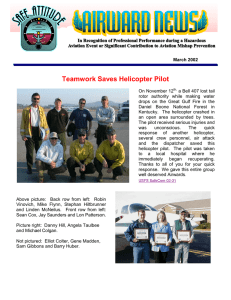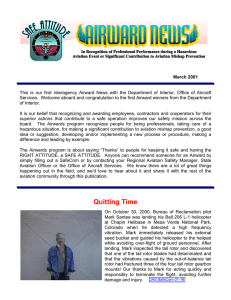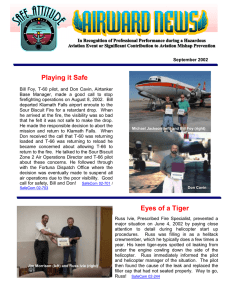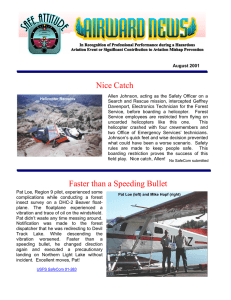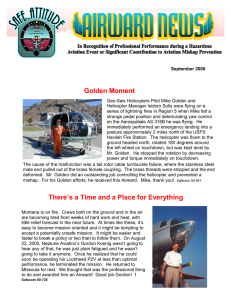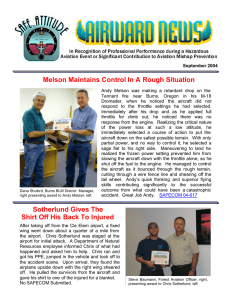SAFECOM Summary January-May 2011 SAFECOMs by Aircraft Type FOREST SERVICE AVIATION RISK MANAGEMENT
advertisement
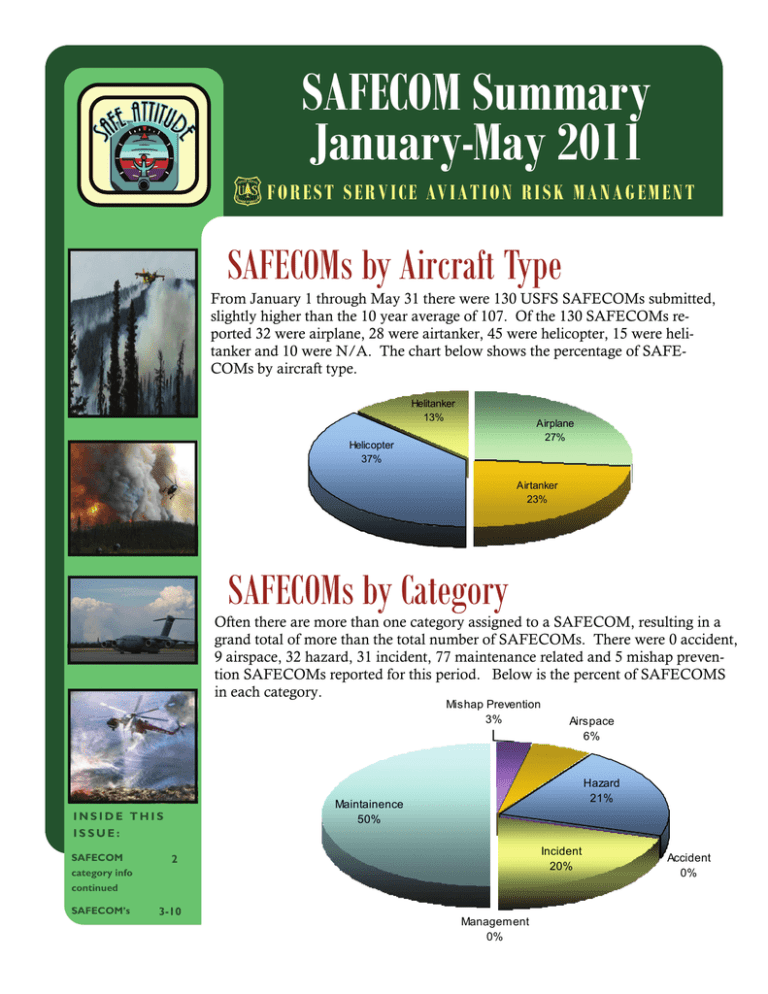
SAFECOM Summary
January-May 2011
F O R E S T S E R V I C E AV I AT I O N R I S K M A N A G E M E N T
SAFECOMs by Aircraft Type
From January 1 through May 31 there were 130 USFS SAFECOMs submitted,
slightly higher than the 10 year average of 107. Of the 130 SAFECOMs reported 32 were airplane, 28 were airtanker, 45 were helicopter, 15 were helitanker and 10 were N/A. The chart below shows the percentage of SAFECOMs by aircraft type.
Helitanker
13%
Airplane
27%
Helicopter
37%
Airtanker
23%
SAFECOMs by Category
Often there are more than one category assigned to a SAFECOM, resulting in a
grand total of more than the total number of SAFECOMs. There were 0 accident,
9 airspace, 32 hazard, 31 incident, 77 maintenance related and 5 mishap prevention SAFECOMs reported for this period. Below is the percent of SAFECOMS
in each category.
Mishap Prevention
3%
Hazard
21%
Maintainence
50%
INSIDE THIS
ISSUE:
SAFECOM
category info
Incident
20%
2
continued
SAFECOM’s
Airspace
6%
3-10
Management
0%
Accident
0%
PAGE
2
SAFECOM’s by Category continued
ACCIDENT - We have started this year off with NO accidents. Way to go!
AIRSPACE - There were 9 airspace events reported, of which 5 were intrusions
and 3 were procedural. Just because there is a TFR it may not keep other aircraft
away from the area. Surprisingly three of the five intrusions reported were not private aircraft but instead Life Flight, Air Force, and Border Control. Don’t let your
guard down because there is a TFR. Also because of the high fire activity along the
Mexican Border this spring, it is critical to know our agency coordination and approval process concerning flights in and out of Mexico.
HAZARD - There were 33 hazard events reported. Communications accounted
for half of all the hazards category. Issues most commonly included high volumes
of radio traffic, frequency interference and human error. Pilot actions and weather
combined for half of the remaining hazards reported, many resulting in “kudos to
the pilot”. There were two issues related to PSD machines and the spheres.
INCIDENT - Reported in this category were three dragged loads and two bird
strikes. There were 16 reports classified as other, in which 8 were related to rappel
training. Note: Reporting rappel tower training and equipment issues in the SAFECOM System is now part of the new Quality Assurance Process established within
the National Rappel Standardization Program.
MAINTENANCE - Fifty percent of the reports submitted had issues associated
with maintenance. Engine being such a broad category, again had the most reports
with 22. There were 5 reports related to mission equipment, 3 of which involved
PSD machines, and 7 each for hydraulic and fuel.
MANAGEMENT - There were no management SAFECOMS reported.
MISHAP PREVENTION - There were five mishap prevention reports. Three involved flight crews discovering cracks on their aircraft, one involved a precautionary landing due to weather and one involved a pilot respecting his personal limitations with a longline. Great job folks, keep up the good work.
SAFECOM Working Group
(SWG) Update
The SWG completed the analysis of the SAFECOM survey last fall, the SAFECOM Survey Report
Results are available on the SAFECOM website. First and foremost the SWG would like to Thank the
folks that participated in the survey; your feedback was invaluable. We also added a SAFECOM
Comments/Suggestion link on the website so you can continue to send us your thoughts and ideas.
The SWG recently posted the SWG Progress Report, on the SAFECOM website as well. This is a list
of improvements and suggestions with the status for the SAFECOM program and website.
SAFECOM SUMMARY
JANUARY-MAY 2011
FOREST
SERVICE
AVIATION
RISK
MANAGEMENT
SAFECOM’s
PAGE
3
These are samplings from the SAFECOM’s submitted for the months of January-May. We hope you
will select a couple of them a day to discuss and use the lessons learned in you daily briefing. Some of
the SAFECOM’s have been edited due to length, to read the SAFECOM in it’s entirety, please click
on the link.
SAFECOM 11-329: A crack was discovered in an inboard L/H flap track by vendor’s DER {Structural
Engineer}. The aircraft was safe to fly, the track would be inspected every 10 flights and the damage
would be repaired within 30 days. The preferred repair method would have been blending to remove the
crack. When this repair was being undertaken, it was revealed that a previously accomplished substandard repair was the origin of the crack in question and a determination was made by the vendor to replace the flap track. Aviation Maintenance inspector was contacted with the issue. CORRECTIVE ACTION: The replacement of the flap track was completed as per the applicable approved data and details
are on file with the vendor work . Aviation Maintenance inspector was informed with the repairs and at
this time the airtanker was placed back to contract availability. RASM comments: This is the second flap
track crack to be found this season. Reporting this issue, helped make us aware, and for the second flap
track to be recognized. Kudos to the vendors for sharing this information and for reporting this second
event for trending. Similar to: SAFECOM 11-298
SAFECOM 11-328: During a personnel transport mission the a/c returned to helibase with a hand crew
member in the right front seat. CORRECTIVE ACTION: All personnel at the helibase were re-briefed
that only qualified managers or personnel approved by the helicopter foreman {such as qualified trainees
learning front-seat procedures} will be permitted to ride in the right front seat. RASM comments: A way
to mitigate the risk of personnel sitting behind live dual controls on a medium helicopter is to ensure a
level of training {such as helicopter manager or trainee} for the individual. This is a good reminder for us
of the best practice. A good follow through ensured that everyone on the helibase understood what
needed to happen. Contract Reference: The exclusive use contract {pg C-24} states: {g} Dual Controls
are required and shall be made accessible to an approved agency Helicopter Inspector Pilot {HIP} for all
pilot performance evaluations. During flight operations the front seat not occupied by a pilot may only
be occupied by a Helicopter Manager, or a briefed and authorized {by PIC or HMGR} aerial observer.
SAFECOM 11-323: An airtanker was dispatched from Fort Huachuca tanker base to a new fire located
18 miles southeast of Patagonia, AZ near the U.S. Mexico border. The tanker was one of the first aircraft
on the fire, along with an air attack, and a lead-plane. While transitioning from one side of the fire to the
other, around the heel, the tanker inadvertently crossed into Mexican airspace. Dispatch was notified; the
tanker completed his drop and returned to Fort Huachuca tanker base to reload. The tanker entered
Mexican airspace without the permission of the local dispatch center, and it had not been coordinated in
advance. This coordination and approval process is critical, given the numerous organizations that operate along, and monitor, this international border. CORRECTIVE ACTION: Communications were
conducted within hours of the incident, between the pilot and key officials, to understand and prevent
this from occurring again. RASM comments: There was a fair deal of confusion as to how far into Mexico firefighting aircraft can go based on the State Department agreement. Information Bulletin 2011-02
covers this in depth. Resources working in the border area should brief on the bulletin and understand
what needs to occur. Thanks for sharing your experience and increasing awareness for everyone.
SAFECOM SUMMARY
JANUARY-MAY 2011
FOREST
SERVICE
AVIATION
RISK
MANAGEMENT
PAGE
4
SAFECOM’s continued…...
SAFECOM 11-319: On 5/27/2011 at 1735 the pilot relayed to me {HMGB} that earlier in the day,
while coming off a drop a Lead Plane (LP) was below them and to the right. They were not in commo
w/ the LP or aware it was going to be there. I notified the Helibase manager immediately of the situation. PILOT comments: I was supporting Div F. with water drops. The radios were quite busy and the
area was smoky. I came off the drop through the smoke when movement caught my eye from across the
cockpits right chin bubble. It was the LP which was approx. 300` below us and approx. 1/4 mile to my
right side. I was caught by surprise and turned my aircraft to the left. There were no radio calls that we
heard as to what the LP was doing. If he was making radio calls, we never heard him or acknowledged
his radio calls. The right seat pilot called him on the radio afterwards and the LP said he was making
calls. I feel he should have waited to do his run until we answered his radio calls, if he was making them.
Communication is when someone says something and the other person responds and understands. If we
would have heard the LP’s radio calls we would have responded and not been caught by surprise, it
would have been no big deal. CORRECTIVE ACTION: RASM comments: Follow up is occurring. The
reported distance of 300` is alarming and puts this event into the realm of a near mid-air. There are lots of
red flags in this scenario- ATGS transition, frequency congestion, a complex air show. Positive communication is critical all the time, but as these red flags pop up, efforts by all need to be made to ensure appropriate communication is in place. Stay tuned for more information and discussion items. Similar to
SAFECOM 11- 152
SAFECOM 11-317: Air Attack informed helibase that helitanker had conducted a precautionary landing
adjacent to the Ringo retardant dip site with an intermediate gear box indicator light. Mechanics and
manager drove to the location. Upon inspection mechanics replaced the pressure switch for the gear box
and conducted a run up of the aircraft. It was determined that replacement of the pressure switch was the
cause of the indicator light. Due to the time of day, the aircraft was left in place and pilots were driven to
a place of lodging thus exceeding their 14 hour duty day by one hour { 2100}. CORRECTIVE ACTION: AMI was contacted and aircraft was returned to contract availability. RASM comments: The
maintenance issue was resolved with good communication and conservative decision making on the part
of the pilots. The submitter also notes a policy deviation in the extended pilot duty day caused by responding to the situation. The pilots were given additional time off to ensure they met the rest requirements. With pumpkin time approaching, driving the pilots was lower risk than rushing the maintenance
to get the aircraft back. No further action required.
SAFECOM 11-314: While flying to the mobile retardant base a Helitanker spotted a white Hughes 500
flying inside the TFR. Dispatch was immediately notified with the information and attempted to determine ownership. The team Liaison Officer was notified and questioned about Border Patrol flights being
conducted in the area. The Liaison called his CBP contact who stated that their aircraft had been in the
area. After an additional follow up call with CBP it was discovered that the intrusion aircraft saw the
Helitanker, realized they were close to fire aircraft, and turned and departed the area. During this time
Dispatch had contacted AMOC who had also determined that the aircraft was a CBP aircraft. CORRECTIVE ACTION: Dispatch made contact with their CBP Liaison to assist in making the appropriate
contacts to avoid any additional encounters in the future. The team liaison arranged a meeting with a
CBP official to discuss future cooperation with the team and CBP ground and aviation resources. Team,
Forest, and District personnel attended the meeting. FAO comments: Center Manager briefed the FAO
on the events and emailed the point of contact for DHS pilots. Protocols were re-enforced and radio frequencies communicated. Good follow through by Dispatch and Team. RASM comments: The border
between the USA and Mexico has a high aviation level for a variety of reasons. Even with protocols in
place, folks need to be vigilant and maintain awareness when operating in the border area.
SAFECOM SUMMARY
JANUARY-MAY 2011
FOREST
SERVICE
AVIATION
RISK
MANAGEMENT
SAFECOM’s continued…...
PAGE
5
SAFECOM 11-308: In a 7000`ft right orbit over the Gold Fire, a single engine civilian aircraft crossed in
front of us at our elevation. Separation was approximately 1/4 mile. A/C did not show on TCAS. No
other A/C was on the fire. CORRECTIVE ACTION: FAO Comments: The proximity of the Forest to
the Phoenix Metro area and a high volume of recreational aviation traffic increase the potential of general aviation encounters/intrusions into the fire traffic area during initial and extended attack when no
TFR is in place or even warranted. We will ensure that this issue is covered in briefings for all aviation
users. RASM comments: The submitter points out a great reminder to keep your head up and be maintain situational awareness. People are attracted to smoke and that includes pilots too.
SAFECOM 11-303: Vendor personnel washed the A/C after several missions in very dusty conditions.
At 1900 the Pilot and Helitack Supt. were preparing to ferry the A/C from Rucker Helibase to Douglas,
AZ for the night, the A&P had left earlier to drive the pilot once at the airport. When the start sequence
was initiated the main rotor gear box chip light detector was flickering amber. The pilot immediately
stopped the sequence. The pilot was flown back to Douglas on another A/C and left his A/C at the helibase for the night. CORRECTIVE ACTION: The A&P returned to the A/C the next morning he pulled
the upper and lower chip detectors on the main rotor gear box and inspected them. There was no evidence of fuzz or a chip. The pilot and mechanic did a ground run and maintenance test flight and did not
experience the chip detector warning light again. It`s the A&P`s diagnosis that water had gotten on the
chip detectors wires and seal and had given a false indication, once the water had dried overnight the
chip detector was working properly. Acting RASM comments: Spoke with AMI and he was informed
and put the aircraft back in availability status 5/20 @ 0930. No further action required.
SAFECOM 11-301: A helicopter on a ferry flight to an incident experienced an unpredicted spring squall
in northern Nevada. With blowing rain and snow, visibility quickly became very limited. Known hazards
in the area {terrain and power lines} necessitated an immediate unscheduled landing of the aircraft.
CORRECTIVE ACTION: With less than five miles to the local airport, the pilot immediately conferred
with the helicopter crew and an appropriate landing site was identified. With the assistance of `spotters`
in the rear seats, the aircraft landed safely on a nearby ridge. Hours later, when the storm subsided, the
ship was relocated to the airport. The pilot and crew should be commended for their decisive action, as
well as for placing the safety of themselves and their equipment before their mission objectives. RASM
comments: Pilot showed good judgment. No further action required. Similar to: SAFECOM 11-320
SAFECOM 11-293: We arrived over the Horseshoe 2 fire and ordered up four helitankers for retardant
drops and had a type 3 helicopter over the fire on a recon. I started having trouble hearing my pilot on
the intercom and radio communications on victor and FM frequencies. My pilot could hear all radio
transmissions clearly, but not me. Shortly later I could hear nothing. We tried replugging and switching
headset and checking to make sure volume knobs and toggles were in the right position and there was
still nothing on right side avionics panel. We then switched my headset to pilots side where I could communicate with incoming aircraft, helibase and ground personnel. I communicated with pilot verbally and
with hand signals as he could hear nothing thru intercom. We communicated this way until relief arrived
over fire. CORRECTIVE ACTION: Right side mixer box was found to have bad solenoid and mixer
box was replaced. RASM comments: Most of our SAFECOMs this season deal with communication in
some form. Having positive communication is vital to aviation safety. In this case, they found a workaround for the issue. The situation must be evaluated and if communication levels are complex workarounds might not be the best answer.
SAFECOM
SUMMARY
JANUARY-MAY
2011
FOREST
SERVICE
AVIATION
RISK
MANAGEMENT
PAGE
6
SAFECOM’s continued…...
SAFECOM 11-279: Upon inspection on day off, mechanic was performing inspection and discovered a
crack in wing root hat fitting on the right wing. Crack went through 3 rivets and one inch past the third
rivet. Director of maintenance was notified and came in and bore scoped the fitting to verify the damage
and made determination to fly aircraft back to home base. Aircraft was unavailable at 0900 on
05/14/2011. Maintenance inspector witnessed the bore scoping performed on the hat fitting and agreed
with findings. CORRECTIVE ACTION: RASM comments: This aircraft will be out of service for an
extended period of time while the issue is resolved. Kudos to the mechanic for a thorough inspection and
finding the crack. His action demonstrates a strong commitment to aviation safety.
SAFECOM 11-276: After take-off, pilots smelled fuel in the cockpit and immediately returned to airport.
CORRECTIVE ACTION: Mechanics checked aircraft for leaks and found none. The ship had taken off
right after an airliner so pilots and mechanics assumed it was from the airliner. RAMI notified and OK’d
ship to return to work. Thanks to the pilots for being cautious and returning to get things checked and
RAMI for being available on the phone to get ship back on the fire. GOOD JOB to all! RASM comments: The pilots made good risk decisions when faced with this situation. Great call to return and check
things out. Once they determined things were normal, they returned to work. Great example of the safety
culture we want as an Agency.
SAFECOM 11-261: During Veteran Rappel Recertification a rappeller experienced a procedural break
by locking off without hooking up and presented to the Spotter. The Spotter witnessed the error and
stopped the operation at the point of presentation. This occurred on the rappellers second cycle through
the high tower simulator. CORRECTIVE ACTION: The issue was debriefed with Rappeller, Spotter,
and Check Spotter.
SAFECOM 11-251: Flight departed transporting 3 passengers, it was later determined that aircraft card
had expired. CORRECTIVE ACTION: FAO Comments: Vendor was reminded that it is their responsibility to request timely carding from Regional Inspectors, Forest Aviation Staff contacts or COR. FAO
reminded all Forest Aviation Staff to check cards when scheduling services. RASL Comments: Will discuss with aviation group to seek ways to prevent recurrence.
SAFECOM 11-243: Manager of the helitanker was informed by the flight crew that the BIM (Blade Inspection Method) indicator on the blade had activated. The blade was inspected and it was determined
that the blade had to be removed. The Pilot{s} and maintenance crew chief immediately took the aircraft
out of service. CORRECTIVE ACTION: A new blade was driven down from the contractor’s home
unit immediately. Due to the effective and diligently timed actions of the entire flight crew (pilots, maintenance & drivers) a blade was delivered to the aircraft within 24 hours and the aircraft was put back into
service. The flight crew should be recognized for their professional attention to detail and performing
such actions safely and within policy in order to provide the federal government with the best product
possible. All actions were reviewed and approved by the Region 3 Maintenance Inspector.
SAFECOM 11-219: While flying a fire recon mission and looking for cattle that had entered the fire
area, a large bird flew under the rotor system. The pilot tilted the helicopter to the side so it wouldn`t hit
the main rotor system. CORRECTIVE ACTION: As a crew we discussed the importance of having at
least one set of eyes watching the sky for hazards. RASM comments: Great lesson. We all want to do a
good job and in this situation, everyone was focused down on the ground locating cattle. Briefings took
place both in the aircraft and later at helibase to discuss the event. Thanks for reminding us to keep our
eyes scanning in all directions to identify hazards. Similar to: SAFECOM 11-235
SAFECOM SUMMARY
JANUARY-MAY 2011
FOREST
SERVICE
AVIATION
RISK
MANAGEMENT
SAFECOM’s continued…...
PAGE
7
SAFECOM 11-191: At the field portion of A-219 {helicopter transport of external cargo} training
course, interagency personnel were recertifying with external cargo operations. The operation consisted
of a remote helibase and two sling sites. The helicopter had placed and received many loads at the sling
site throughout the morning without incident. After a brief shut-down to troubleshoot the helicopter radios, the helicopter resumed and the pilot approached H-2 with 100 foot longline. The pilot informed
ground personnel that he was going to take an orbit around the sling site to see what the winds were doing. As the aircraft started its orbit around the sling site, the net on the longline struck about 10 juniper
trees approximately 10 feet into the trees canopy. The pilot was promptly notified about the load striking
the trees. CORRECTIVE ACTION: Upon witnessing the load striking the juniper trees the helispot
manager took control of communications with the pilot from the trainee, and notified the pilot that the
load had struck some trees. The pilot corrected his flight and placed the load in the correct location. The
helicopter manager trainee was promptly notified as well via cell phone by the helispot manager. The
remainder of training proceeded without further incident. RASM comments: This was a training event
utilizing Forest Service pilots: which allowed the pilots to regain their longline proficiency. HIP comments: The pilot was distracted and lost situational awareness, allowing the helicopter to descend. Once
the load contacted the trees and the pilot received a radio call from the ground personal the pilot adjusted
the elevation of the load for all subsequent approaches. NASS: ``If you SEE something, SAY something`` Kudos to those on the ground for contacting the pilot via radio and not making the assumption he
knew he hit the trees. UAO (acting): I was notified of the SAFECOM by the helicopter manager trainee.
There was an AAR conducted after the training. Good reaction by the qualified helispot manager. Very
real life situation that may be encountered during the fire season, so if handled correctly, they will have
this slide for the future. Similar to: SAFECOM 11-189
SAFECOM 11-342: While enroute to the Murphy fire, the number one engine was shut down and feathered in flight due to the inability to govern engine RPM with either the master lever or toggle switch.
Tanker notified Show Low Dispatch and Winlsow ATB that they needed to turn around and return to
INW. The retardant load was jettisoned at high altitude in the designated area and the aircraft landed
safely. CORRECTIVE ACTION: The governor was replaced and a check of the wiring associated with
the governor revealed no defect. During the feathering operation, the feather pump stuck on and was
damaged by overheating. The feather pump relay was inspected with no defect noted and it was suspected the defective governor failed to terminate the feathering operation. The feathering pump motor
was replaced. A full run up and high speed taxi test revealed no further defect. Tanker was then returned
to contract availability by AMI. RASM comments: Good communication in resolving this issue. No further action required.
SAFECOM 11-114: While flying a fire I noticed the fuel indicator on the dash indicating no fuel and
then coming on and showing full fuel. We left the fire and flew back to base. CORRECTIVE ACTION:
The mechanic is currently working on the problem on site and has ordered new parts for replacement. In
the meantime the company is sending a replacement A/C. The maintenance inspector will follow-up
with contractor as to fix made on aircraft. Replacement aircraft was ordered. Vendor will follow up with
me via fax when issue is fixed. No further comments
SAFECOM 11-120: During preflight inspection, the pilot noticed a crack in the power section of the engine, an area that is not readily visible. The pilot informed the mechanic and he cleaned the area confirming that there was a crack. I called our maintenance inspector and informed her of the crack and what
the mechanic was working on. Good job by the pilot for being very thorough on his preflight inspection.
This is WHY we give pilots and mechanics plenty of time to do their morning preflight. CORRECTIVE
ACTION: Replaced damaged component.
SAFECOM SUMMARY
JANUARY-MAY 2011
FOREST
SERVICE
AVIATION
RISK
MANAGEMENT
PAGE
8
SAFECOM’s continued…...
SAFECOM 11-126: During aerial ignition operations the Premo machine
jammed. I let pilot know we had a problem and proceeded to try to clear the
jam. I could not clear the jam by turning the knob so I used the water button
and poured a small amount of water from the canteen into the hopper to make
sure no fire could be present. The pilot held the aircraft in hover over burn unit
while this was being done. When we were sure there was no fire, we landed at
a field that was just off the edge of the burn unit. I found a bent needle that had
machine jammed. Also during this flight, I found 2 halves of a premo ball at
different times while pouring balls into hopper. During the final flight of the next day, one chute quit
feeding balls. When we landed and checked it out, we found a half of a ball capped onto another ball
making it too large to fall down feed chute in hopper. CORRECTIVE ACTION: When landed and
found the bent needle, we broke the needle off to get it out of the way. No other problems found with the
machine. We put tape over the hole from the chute with the broke needle to
block the balls from falling into it. This would allow us to complete the last few
minutes of the burn and not drop balls that are not injected. When we returned to
the helibase, we replaced the needle and everything checked out good. RASM:
Spoke to submitter to confirm no glycol leaks with method used to repair PSD
machine and asked to keep an eye on possible imperfections in spheres similar to
the problem encountered last year with splits in spheres. See: Accident Prevention Bulletin 11-01
SAFECOM 11-115: Prior to departure from HSP for RX, the manager asked pilot to do a new load calculation due to an increase in temp. Previous load calcs. had been done for 10 degrees Celsius and this
one was done for 25 degree Celsius. Manager and pilot signed load calc and mission was started. While
the operation was in progress manager reviewed the load calc and was alerted to the fact that there were
some questionable computed gross weights and a math error. When the aircraft landed to refuel manager
alerted pilot to math error and asked as to how the pilot to explain. The pilot could not explain or show
the manager the chart he was using. The manager then started looking at all of the past load calcs. that
had been done by current pilot and one other pilot and had been signed by two different managers. There
were many math errors, the pilots were using two different references and performance charts, and the
performance charts listed in the manager’s copy of the contract were different than the performance
charts listed in the vendor’s copy of the contract on board the aircraft. CORRECTIVE ACTION: Manager called Regional Inspector pilot and discussed what charts they should be used and it was agreed that
the manager, pilot and Inspector pilot would have a conference call to ensure that everyone was using the
correct charts and ensuring the math was done correctly. The manager ensured that the references used
were the same in both contracts and that current pilot and incoming pilots were aware of what reference
and performance chart to use. This is a reminder to EVERYONE that simply checking the math on load
calcs. and looking through the contract is not only the Vendors responsibility but the Manager`s also. R8
HOS: This again shows why attention to detail is so important. Nothing is more so. R8 RASM: This particular type of error is not uncommon in the field. Pilots should review their performance planning with
their company and ask the HIP to go over their planning whenever the opportunity occurs.
SAFECOM 11-307: Between long-line missions, and just prior to hot fueling, the helicopter mechanic
noticed a leak from the #2 hydraulic pressure line during his walk around inspection. CORRECTIVE
ACTION: The pilot and crew were notified of the leak, the aircraft was shut down and the hydraulic line
was quickly replaced. Because of the mechanic`s attention to detail and timely action, a more serious
situation was avoided. RASM comments: Kudos to the mechanic for paying attention to detail and potentially avoiding a serious situation. No further action required.
SAFECOM SUMMARY
JANUARY-MAY 2011
FOREST
SERVICE
AVIATION
RISK
MANAGEMENT
SAFECOM’s continued…...
PAGE
9
SAFECOM 11-096: The Forest Service airplane was in Sitka, AK getting
the Annual Inspection done. The airfield was experiencing 80 MPH winds
and the tie down ropes broke and the aircraft rolled to the left and came to
rest on the left wing. While they were trying to secure the aircraft the plane
rolled back 4 times while impacting the rear keel of the floats. There is
damage to the left out board wing, tip tank, aileron, and hinge bracket: also
left float has some damage. RAMI/FAO has been notified and will follow
up. CORRECTIVE ACTION: RAMI Comments: Went to Sitka to inspect the airplane. We are formulating a course of action on getting the aircraft repaired.
SAFECOM 11-157: The NIFC/Communications Duty Officer {CDO} was notified that there was a
new fire with a Type II IMT assigned. When the CDO was talking to dispatch, the question was asked if
there was going to be a need for an air-to-air {A/A} AM frequency and he said yes. The CDO submitted
a request to the FAA for 1 A/A AM frequency for the specified Lat/Long. The FAA contacted the CDO
and assigned a frequency for the fire. The next day the CDO advised the COML that the FAA had assigned a frequency of 122.075 for A/A use on this fire. The COML informed the CDO that the team had
said that they already had a frequency of 123.4500 and they wanted to use this frequency because it was
easy to remember. The CDO did not think anything of this assuming that this was a state frequency and
the team had authority to use this as an A/A AM frequency. It was later discovered that they did not
have authority to use the frequency. Just because a frequency is easy to remember does not give anyone
the authority to use whatever frequency they want. That frequency is a Flight Test frequency that is used
throughout the US with very heavy use in Florida. The potential for interference is great and could therefore cause an unsafe environment for the authorized licensee and the incident aircraft. Although there
was no reported interference on this frequency, there was a huge potential for interference. The process
for A/A AM frequency use on incidents is to have ALL A/A AM frequencies assigned to an incident by
the FAA, through the NIFC/CDO. CORRECTIVE ACTION: ALL Frequencies MUST be ordered
and coordinated through the NIICD CDO. IT IS NOT ACCEPTABLE to use frequencies that have not
been assigned to an individual incident, this is extremely unsafe and in violation of the agreement with
the FAA. If the FAA pulls the frequencies from us we would then have to go to them for every assignment on a daily basis. Right now the FAA has provided 148 A/A AM frequencies throughout the US for
Initial Attack communications zones. The FAA also provides all the frequencies for all wildland fire and
all risk incidents. This is not just a problem with A/A AM, it also includes air-to-ground FM and tactical frequencies. Frequencies are a National Resource and they must be managed, coordinated and assigned to protect the authorized users and licensees.
SAFECOM 11-313: On a routine visit of Helicopter and Helibase operations an Aviation Safety Technical Assurance Team {ASTAT} discovered a discrepancy in Load Calculations. Ultimately it was determined that incorrect operating weight limits were being used. The ASTAT used this opportunity to educate the helicopter managers and pilots. Dealing with various makes & models of aircraft, compounded
by the changing elevations, temperatures and density altitudes, it’s important to ensure the proper charts/
limits are being used for current conditions one could be operating in. CORRECTIVE ACTION: If
there are questions about the load calculation process, there are multiple resources available for help. Assistance teams {ASTAT & FAST}, Helicopter Inspector Pilots, Aviation Maintenance Inspectors and
Helicopter Operations Specialists are available to assist. RASM comments: This is the type of report the
SAFECOM system is made for. These folks discovered the hazard of using the wrong charts and want to
share their lesson to prevent a mishap down the road. The submitter stated the issue and a way to solve
the issue well. Great one to brief your crews and pilots on!
SAFECOM SUMMARY
JANUARY-MAY 2011
FOREST
SERVICE
AVIATION
RISK
MANAGEMENT
PAGE
10
SAFECOM’s continued…...
SAFECOM 11-218: During veteran annual currency training, two individual
rappellers experienced Bourdon snap hook gates staying open during spotter or
rappeller checks. The issue seems to occur on hooks with a tighter tolerance between the gate and the shank of the snap hook. The scenario was hard to duplicate on both hooks, but could be if the gate was force hard enough against the
shank. In addition there are Bourdon snap hooks that appear to have not been
“peened” on the detent pin from the factory. CORRECTIVE ACTION: Both
hooks were removed from service.
SAFECOM 11-281: Helitanker was conducting water dropping missions from dipsite {east side of incident} to fire {west side of incident} when the pilots observed a type 2 helicopter in front and above them
{approx. 300` or more} with a 100` longline with load. Helitanker pilots indicated that aircraft from the
Gypsy helibase were flying missions from north to south while helitankers were flying from the east to
west. Pilots also indicated that the area was heavily smoked in as well. CORRECTIVE ACTION: All
helitanker pilots and air attack personnel briefed together regarding communications and `call in points`
when working the incident. Additional recommendations called for possibility of using a HLCO for coordination if needed. RASM comments: Another helicopter pilot saw the event and estimated the distance
between the two helicopters at 700-800 feet. Good follow through on the part of the AOBD to address
the congestion issue. Multiple aircraft in the same area {whether military, general aviation or incident} is
a huge concern. Establishing travel routes and call in points mitigate some of the risk, but communication still needs to occur. This is a good reminder that see and avoid applies to the Fire Traffic Area also.
SAFECOM 11-305: On the first air tactical flight by ATGS during first shift of the transition between
two Type I IMT`s on relatively large wildfire in steep, rough terrain. ATGS had flown fire on one sortie
over fire with outgoing ATGS and was familiar with operational challenges, terrain, and potential operational issues. Changes in air operations direction was completed in the new team IAP {220}, but not included on Comm Plan {ICS 205}. These changes and expectations, including potential use of tactical frequencies for air-ground ops, was not discussed clearly by ATGS during first am air operations briefing
with pilots. During initial part of the flight ATGS encountered static on secondary VHF-AM radio and
changed frequencies for air-air operations away from normal `rotor wing` frequency for incoming Type I
helos to fire. In addition, ATGS requested that one incoming Type I helo use an established tactical frequency for air-ground communications with a specific crew. Though this was cleared with Division and
confirmed with crew by ATGS, it created confusion and anxiety with other helo pilots. Transition periods of IMT, during team transition, have always been the 19th watch out situation where problems and
accidents have occurred. Not clarifying intent of changes in frequency nomenclature and use, during
morning Air-Ops briefing, and initiating changes on first air operations shift of the day, created confusion, anxiety, and undue stress on pilots in the fire operations area. CORRECTIVE ACTION: 1.
ATGS discussed concerns and issues expressed by pilots with HBM and helo managers, and explored
remedial actions. 2. ATGS discussed situation and issues with team ASGS, with recommendations for
changes in IAP and need to fully disclose and discuss expectations at next am Air-Ops briefing. 3. Recommendations include: *Ensure that IAP reflects standard language used by team consistently across
IAP {ie. primary/secondary A-G, not primary/bucket A-G.} *Fully discuss concerns, issues, and expectations for flexibility at am Air-Ops briefing with managers and pilots. *Ensure that all helo managers/
pilots program Comm Plan in each aircraft, with discussion of expectations for use of tactical frequencies
for Air-Ground operations as needed for safe and efficient air operations. *ATGS implement air operations plan, and continue obtaining feedback on effectiveness of plan implementation. RASM comments:
Transitions have been shown to be a time of higher risk to operations. Communication and operational
understanding is critical. Thanks for reporting and raising awareness.
SAFECOM SUMMARY
JANUARY-MAY 2011
FOREST
SERVICE
AVIATION
RISK
MANAGEMENT
